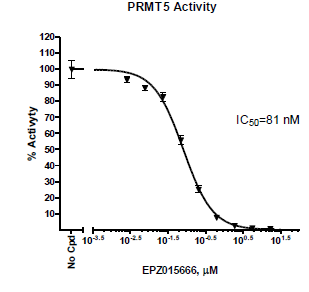PRMT5 TR-FRET Assay Kit
The PRMT5 TR-FRET Assay Kit is designed to measure PRMT5 activity in a homogeneous 384 reaction format. PRMT5 is a histone methyltransferase that exhibits methylation activity toward H4-R3. This FRET-based assay requires no time-consuming washing steps, making it especially suitable for high throughput screening applications. The key to the PRMT5 TR-FRET Assay Kit is a highly specific antibody that recognizes methylated substrate.
Need us to run inhibitor screens or profile your compounds against PRMT5? Check out our Methyltransferase Screening Services or DNA Replication & Repair Screening Services.
| Catalog # | Component | Amount | Storage | |
| 51045 | PRMT5/MEP50* | 40 µg | -80°C | Avoid freeze/ thaw cycles! |
| 52120 | 60 µM S-adenosylmethionine | 250 µl | -80°C | |
| Eu-labeled antibody | 5 µl | -80°C | ||
| Biotinylated histone H4 peptide substrate | 1000 rxns | -80°C | ||
| 4x PRMT5 assay buffer** | 3 x 1 ml | -20°C | ||
| Dye-labeled acceptor | 2 x 10 µl | -20°C | ||
| 78314 | PRMT5 TR-FRET Detection Buffer | 4 ml | -20°C | |
| 79969 | White, nonbinding, low volume, microtiter plate | 1 | Room Temp. | |
*The concentration of PRMT5 is lot-specific and will be indicated on the tube containing the enzyme.
**Add 10 µl of 0.5 M DTT per vial before use.
PRMT5 is a histone methyltransferase that exhibits methylation activity toward H4-R3. PRMT5 is a critical regulatory-protein linked to genome organization, cell cycle regulation, and stem cell differentiation. PRMT5 transfers methyl groups from S-adenosylmethoinine (SAM) to form mono and symmetric di-methylated arginine residues in histone proteins, transcription factors, and other regulatory proteins. Given its regulatory function, PRMT5 is believed to contribute to tumorigenesis. Its dysregulated activity has been associated with many cancers including lymphomas, lung, and breast cancer. Additionally, PRMT5 has been linked to other diseases including kidney and heart disease as well as neurological disorders such as Huntington’s and Alzheimer’s diseases.


